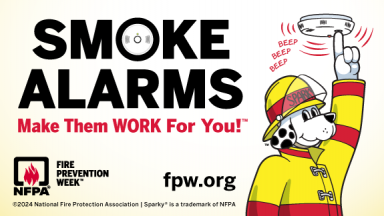The 2024 Fire Safety Tips

On each phone QSOs, we like to read a hint for fire safety. Here is the complete tip list for this year's special event.
- Make smoke alarms work for you!
- You could have very little time to get out safely once the smoke alarm sounds – as little as two minutes.
- Smoke alarms warn you early so you can get outside quickly. For your safety, keep them in good working order.
- Make an escape plan. Have two ways to get out of every room if possible. Practice your plan.
- Know where and how to install your smoke alarms.
- Install smoke alarms in every bedroom.
- Put smoke alarms outside each separate sleeping area, such as a hallway with multiple bedrooms.
- Place smoke alarms on each level of your home, including the basement and garage.
- To install your smoke alarm, follow the instructions that come with it.
- Interconnected alarms protect you best. When one sounds, they all sound.
- If you sleep with the bedroom doors closed, interconnected alarms are best.
- A smoke alarm should be on the ceiling or high on a wall.
- When you install a smoke alarm, write the date when you installed it on the back.
- Do not paint over or cover smoke alarms.
- When you move into a new home or apartment, test all the alarms. Don’t assume that they are working.
- Know how to choose your smoke alarms.
- Your local fire department can help you pick the alarms you need.
- Only buy alarms that are UL, ULC, or Factory Mutual certified.
- The two most common types of smoke alarms are ionization and photoelectric alarms./li>
- An ionization smoke alarm is more responsive to flaming fires.
- A photoelectric smoke alarm is more responsive to smoldering fires.
- Dual-sensor smoke alarms are also available. These have both ionization and photoelectric detectors.
- For the best protection, or where extra time is needed to wake up or help others, use both types of alarms or dual-sensor alarms.
- To reduce nuisance alarms, use photoelectric smoke alarms near the kitchen and bathrooms.
- Know how and when to test and maintain your smoke alarms.
- Test your smoke alarms at least once a month by pushing the test button.
- To keep your alarms working, follow the manufacturer’s instructions for cleaning them.
- Smoke and carbon monoxide alarms with non-replaceable, long-life batteries are designed to remain effective for up to 10 years.
- If an alarm with non-replaceable batteries chirps, this is a warning that the battery is low. Replace the entire alarm right away.
- For an alarm that has replaceable batteries, change the batteries once a year or if it starts to chirp.
- If an alarm with replaceable batteries chirps, replace only the battery.
- Replace the entire smoke alarm every ten years, even if it seems okay.
- For more helpful information, visit the Fire Prevention Week website at www.fpw.org. Also see www.nfpa.org and your local fire and police departments.